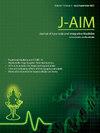Withaferin A reduces pulmonary eosinophilia and IL-25 production in a mouse model of allergic airways disease
IF 1.9
Q3 INTEGRATIVE & COMPLEMENTARY MEDICINE
引用次数: 0
Abstract
Background
Several studies report that ashwagandha, a traditional Ayurvedic supplement, has anti-inflammatory properties. Type 2 (T2) asthma is characterized by eosinophilic airway inflammation.
Objective
We hypothesized that allergen-induced eosinophilic airway inflammation in mice would be reduced following administration of Withaferin A (WFA), the primary active phytochemical in Ashwagandha.
Materials and Methods
C57BL/6J mice were given 10 total intra-peritoneal injections of 2 mg/kg WFA or vehicle control, concurrent with 6 total intranasal administrations of 50 μg house dust mite extract (HDM) or saline control over 2 weeks.
Results
We observed that treatment with WFA reduced allergen-induced peribronchial inflammation and airway eosinophil counts compared to mice treated with controls. In addition, we observed that treatment with WFA reduced lung levels of interleukin-25 (IL-25) but increased lung gene expression levels of its co-receptor, Il17ra, in HDM-challenged mice compared to HDM-challenged mice that received the vehicle control.
Conclusion
This study pinpoints a potential mechanism by which WFA modulates allergen-induced airway eosinophilia via the IL-25 signaling pathway. Future studies will investigate the effects of WFA administration on lung eosinophilia and IL-25 signaling in the context of chronic allergen-challenge.
Withaferin A在过敏性气道疾病小鼠模型中降低肺嗜酸性粒细胞和IL-25的产生
一些研究报告称,传统的阿育吠陀补品印度人参具有抗炎特性。2型(T2)哮喘以嗜酸性气道炎症为特征。目的:我们假设给药阿什瓦甘达中的主要活性植物化学物质Withaferin A (WFA)后,过敏原诱导的小鼠嗜酸性气道炎症会减轻。材料与方法sc57bl /6J小鼠分别腹腔注射10次2 mg/kg WFA或对照,同时鼻腔注射6次50 μg尘螨提取物(HDM)或生理盐水对照,疗程2周。结果我们观察到,与对照组相比,WFA治疗减少了过敏原诱导的支气管周围炎症和气道嗜酸性粒细胞计数。此外,我们观察到,与接受载体对照的hdm挑战小鼠相比,WFA治疗降低了hdm挑战小鼠肺中白细胞介素-25 (IL-25)的水平,但增加了其共受体Il17ra的肺基因表达水平。结论本研究明确了WFA通过IL-25信号通路调节过敏原诱导的气道嗜酸性粒细胞增多的潜在机制。未来的研究将探讨在慢性过敏原挑战的背景下,WFA给药对肺嗜酸性粒细胞和IL-25信号的影响。
本文章由计算机程序翻译,如有差异,请以英文原文为准。
求助全文
约1分钟内获得全文
求助全文
来源期刊

Journal of Ayurveda and Integrative Medicine
INTEGRATIVE & COMPLEMENTARY MEDICINE-
CiteScore
4.70
自引率
12.50%
发文量
136
审稿时长
30 weeks
 求助内容:
求助内容: 应助结果提醒方式:
应助结果提醒方式:


